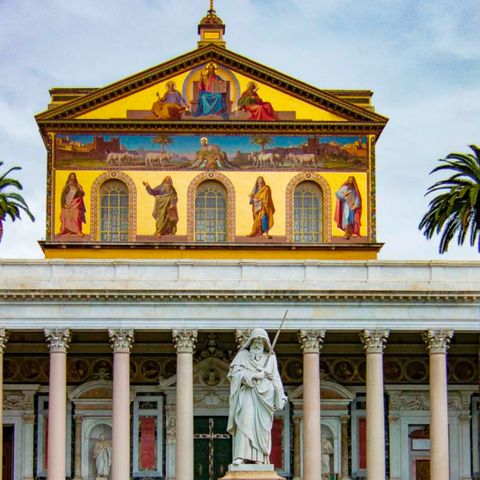November 18: The Dedication of the Basilicas of Saints Peter and Paul, Apostles

Download and listen anywhere
Download your favorite episodes and enjoy them, wherever you are! Sign up or log in now to access offline listening.
Description
November 18: The Dedication of the Basilicas of Saints Peter and Paul, Apostles Optional Memorial; Liturgical Color: White The Apostles Peter and Paul are the Patron Saints of the City...
show moreOptional Memorial; Liturgical Color: White
The Apostles Peter and Paul are the Patron Saints of the City of Rome
The barque of Peter is tethered to two stout anchors
A cathedral is theology in stone, the medievals said, a truism which extends to all churches, not just cathedrals, and to their sacred web of translucent glass, glowing marble, gold-encrusted wood, bronze canopies, and every other noble surface on which the eye falls. A Church mutely confesses its belief through form and materials. Today’s feast commemorates the dedication of two of the most sumptuous churches in the entire world: the Basilica of St. Peter, the oversized jewel in the small crown of Vatican City, and the Basilica of St. Paul Outside the Walls, a few miles distant, beyond Rome’s ancient walls. The foundations of these two Basilicas are each sunk deep into the blood-drenched ground of first-century Christianity, though today’s impressive structures stand proxy for their long-razed originals. If strong churches reflect a strong God, these Basilicas are all muscle.
The present Basilica of St. Peter was dedicated, or consecrated, in 1626. It was under construction for more than one hundred years, was built directly over the tomb of the Apostle Peter, and considerably enlarged the footprint of the original Constantinian Basilica. That prior fourth-century Basilica was so decrepit by the early 1500s that priests refused to say Mass at certain altars for fear that the creaky building’s sagging roofs and leaning walls would collapse at any moment. The ancient Basilica of St. Paul Outside the Walls was consumed by a mammoth fire in 1823. The rebuilt Basilica was dedicated on December 10, 1854, just two days after Pope Pius IX had formally promulgated the dogma of Mary’s Immaculate Conception. The Basilica’s vast classical elegance is breathtaking—its marbled central nave stretches out longer than an American football field.
The two Basilicas were, for centuries, linked by a miles-long, roofed colonnade that snaked through the streets of Rome, sheltering from the sun and rain the river of pilgrims flowing from one Basilica to the next as they procured their indulgences. Rome’s two great proto-martyrs were like twins tethered by a theological umbilical cord in the womb of Mother Church. The pope’s universal ministry was explicitly predicated upon these two martyrs. Rome’s apostolic swagger meant the Bishop of Rome’s headship was not merely symbolic but actively intervened in practical matters of church governance throughout Christendom. The pope, the indispensable Christian, was often depicted in early Christian art as a second Moses, a law-giver, who received from Christ the tablets of the New Testament for the new people of God.
At intervals of five years, every diocesan bishop in the Catholic Church is obligated to make a visit “ad limina apostolorum”—“to the threshold (of the tombs) of the apostles.” This means they pray at the tombs of Saints Peter and Paul in Rome and personally report to Saint Peter’s successor. These visits are a prime example of the primacy of the pope, which is exercised daily in a thousand different ways, a core duty far more significant than the pope’s infallibility, which is exercised rarely.
There is no office of Saint Paul in the Church. When Paul died, his office died. Everyone who evangelizes and preaches acts as another Saint Paul. But the barque of Peter is still afloat in rough seas, pinned to the stout tombs which, like anchors, hold her fast from their submerged posts under today’s Basilicas. A church is not just a building, any more than a home is just a house. A church, like a home, is a repository of memories, a sacred venue, and a corner of rest. On today’s feast, we recall that certain churches can also be graveyards. Today’s Basilicas are sacred burial grounds, indoor cities of the dead, whose citizens will rise from beneath their smooth marble floors at the end of time, like a thousand suns dawning as one over the morning horizon.
Holy martyrs Peter and Paul, your tombs are the sacred destinations of many pilgrimages to the eternal city. May all visits to the Basilicas dedicated to your honor deepen one’s love and commitment to Mother Church.
Information
| Author | Fr. Michael Black |
| Organization | Michael Black |
| Website | - |
| Tags |
Copyright 2024 - Spreaker Inc. an iHeartMedia Company
